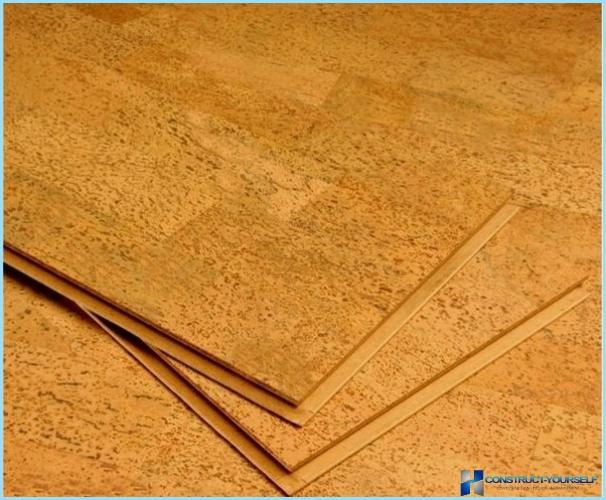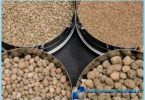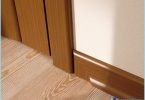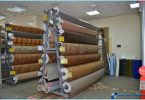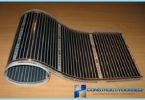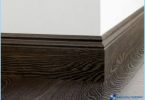The contents
Although the laminate of balsa wood and is so called, it is only with the floor construction, i.e. with the way of connection of boards among themselves. But the laminated upper layer of cork has.
This type of laminate consists of several layers. Below is agglomerated cork mixed with glue. This layer allows to compensate for elevation changes along the rough floor is 2-3 mm and provides sound and heat insulation. Next is a plywood plate, providing the rigidity of the floor and allows you to attach boards together due to grooves and protrusions. The next layer is again extruded tube. Over it is put a veneer of balsa wood. Due to the greater rigidity of the floor it provides durability. As a finish protective coatings are usually lacquer or a thin film of vinyl.
It is believed that due to the springy cork laminate structure reduces the load on the spine when walking. In fact, this effect is not so large and noticeable. But to fall on this floor is far less painful than on the tile or even flooring. So, it is perfect for children’s rooms.
What good is a cork laminate flooring ↑
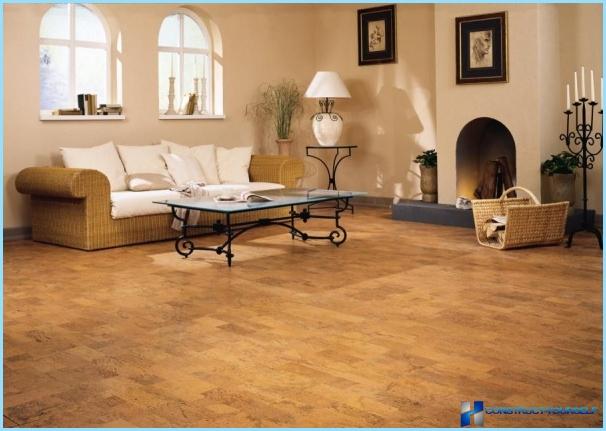
The pros of cork laminate
- long life floor (up to 30 years under normal operating conditions);
- nice appearance;
- the floor is warm to the touch;
- ease of installation (the technology is a little different from the usual stacking of the laminate);
- environmentally friendly;
- hypoallergenicity;
- the material is slightly springy, so fragile items in the fall, as a rule, do not break;
- elasticity, thanks to which indentations from furniture on the floor after some time disappear by themselves;
- the versatility of this flooring (there are types that are suitable even for rooms with high humidity);
- high performance noise and heat insulation;
- due to the rough surface on the floor less noticeable dust.
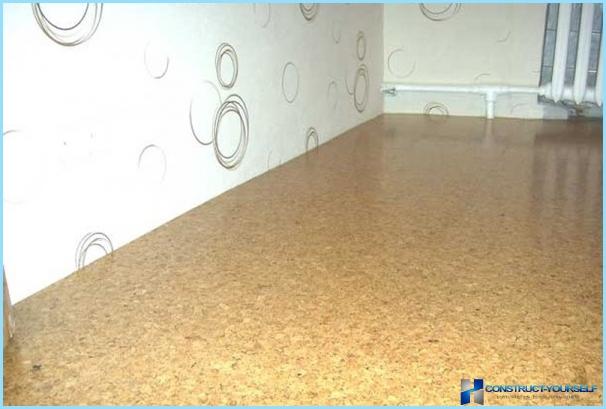
But laminate cork based still not ideal and has drawbacks:
- the high price relative to other types;
- small strength of the floor at a high point loading (for example, when a heavy large piece of furniture on thin legs);
- Lower wear resistance in comparison with laminated coatings. Over time, the places with the greatest permeability are visible gaps and traces. To solve this problem by sanding the damaged areas and applying a special lacquer coating for balsa wood.
How to choose a quality laminate ↑
Signs of quality laminate:
- highest class of durability;
- the level of cuts along the edge of the boards;
- the whole package without any visible damage;
- it is the same size all laminate planks in a pack and inconspicuous line of the joint, when laying the floor;
- a dense bottom layer without foreign inclusions.
Before you purchase cork floor covering a certain manufacturer is to read reviews on it online. If possible, you should visit the official company’s dealers in a particular city. As a rule, in their stores you can see a large variety of cork laminate is not only the photo, but in person, to assess how it looks on large floor areas.
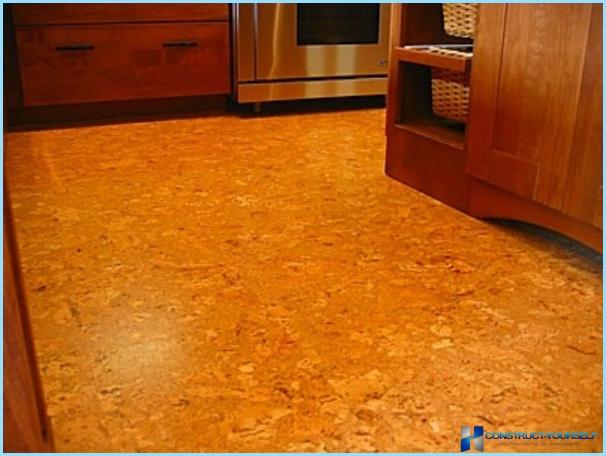
Most manufacturers give cork laminate warranty 10 years, but with careful use of this term is greatly increased.
Cork laminate flooring is sold in bundles, ie to take exactly the required amount is unlikely. If a package is left unclaimed, in the presence of the check and the preservation of its presentation, it can be returned back to the store.
Manufacturers ↑
In manufacturing cork flooring, the leadership reserves the Portugal. Its products are praised for high quality, durability and large selection. Specific brands: «Wicanders», «Сorkart», «ELITER». On the capacity of the Portuguese, and Russian factories produced a brand of laminate «MAESTRO».
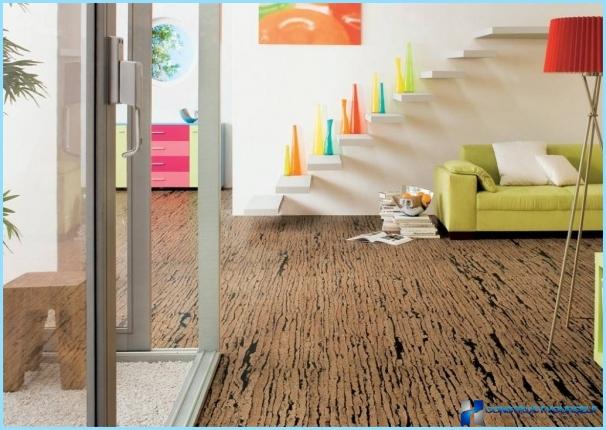
Of other brands of flooring popular:
- «Quick-Step» «Balterio» (Belgium);
- «Tarkett» (Russia);
- «Pergo» (Sweden);
- «Witex», «Proteco»,«Kronotex», «Egger», «Aberhof», «Parador» (Germany).
Cork flooring and laminate flooring are also made in many EU countries and even in China.
The procedure for laying cork laminate flooring ↑
After the delivery of the cork laminate home, its packaging should be opened and leave the material lying on the floor for a couple days. So it adapts to temperature and humidity level of the room. If you neglect this «acclimatization», then after laying the laminate may swell or, conversely, to be pressed down so that the joints of individual boards will diverge.
Since the tube is like any other wood tend to expand and contract when significant temperature fluctuations, then the perimeter of the room must be a gap of about 8-10 mm. it is noticeable will not be as close a plinth. To keep this gap when laying laminate on the floor, the walls are placed the wedges in the absence of which it is possible in principle to use any items of a suitable size, for example, a small plank or trimming of flooring.
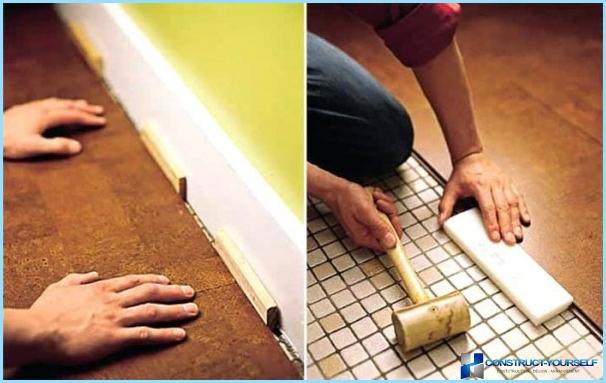
All types of laminate and demanding flatness of the floor. If the elevation changes exceed 2-3 mm per 1 m length of the room, the floor must additional alignment of cement-sand screed, self-leveling floor or other options.
If you made a wet screed, it is necessary to check how well it dried. On the night on the floor, put a glass jar upside down. If in the morning it visible condensation, means to lay laminate even earlier, he starts to sweat, rot, will become the breeding ground for small insects and mold.
From the floor it is necessary to remove all the debris, dust and dirt. Next, it stretches a substrate butt joint. Connection of separate fragments glued tape or masking tape. Some manufacturers offer laminate already glued to it the substrate, which greatly simplifies the work. But often have to buy it yourself. While it is not necessary that the substrate and floor coverings, cork was one manufacturer.
The most common variant of the substrate – foam. If necessary, additional insulation use foil materials. Lining under the laminate can also be cork.
For cutting cork laminate it is recommended to use power tools – a jigsaw or circular saw. When cutting manually will have to spend more time, and the edge of the cut will be uneven.
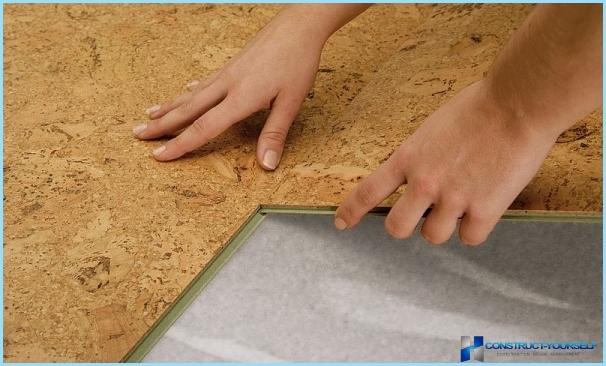
Plank laminate mounted on the floor in a staggered manner, i.e. in two adjacent rows the cross joints should not be near. For a tight and secure fit interlocks on a stacked fragment, tapping the side with a soft hammer or normal, but after a plate or a bar.
Care for laminate flooring ↑
Cork laminate is not very fussy, but compliance with certain rules of operation will preserve its aesthetic appearance and prolong the lifespan.
- Cleaning laminate is a vacuum cleaner or a damp (but not wet) cloth. Use a stiff wire brush and aggressive detergents to clean the cork floor in any case can not.
- To floor less pressed, should give preference to furniture with thick legs. They should «Shoe» in the small pouches out of felt or similar material.
- On the floor, covered with a cork laminate, it is not recommended to walk on the thin heels and rubber shoes.
After disassembly or repair cork laminate it can easily be styled in the same room or other.
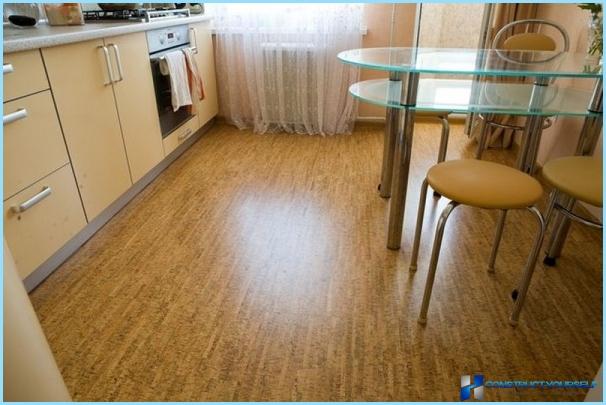
Although on the surface of the laminate with a cork finish accumulate dust and dirt, but deep into the material they penetrate, so can be easily removed when cleaning. The floor is impregnated with a water-repellent mastic, so a damp cloth or even accidentally spilled a Cup of liquid won’t hurt him. But large volumes of water, of course, useful to the laminate will not.
Cork flooring ↑
The difference a cork floor and laminate is quite significant. This floor is a slab of compressed wood with a top layer of veneer and varnished. Although the material cost is a little cheaper than laminate, but will need to buy glue and paints, so that both options of floor covering in the end will be about the same price.
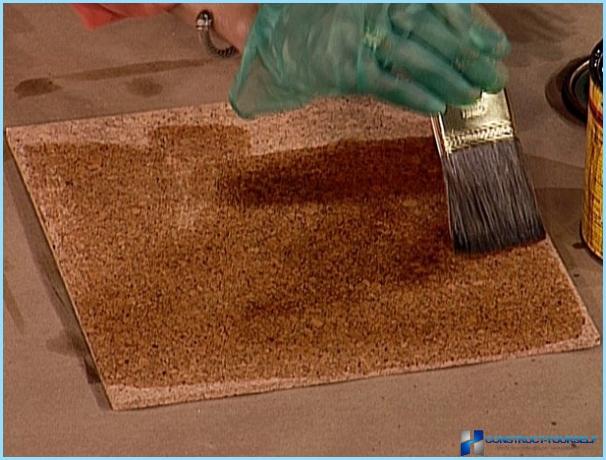
Cork flooring, according to numerous user reviews, absolutely not afraid of water. He isn’t bulging even after flooding with neighbors, broken pipes, leakage of roof and other troubles. But laying cork floor is somewhat more complicated than the laminate.
The installation of the floor – a strong smell of glue and varnish. So strong and unpleasant that within 1-2 days in the room better for a long time not to be, and should be done in a respirator.
Repairing cork floors are easy – damaged piece of a covering is simply cut out, and pasted a new.

